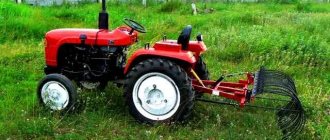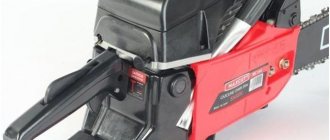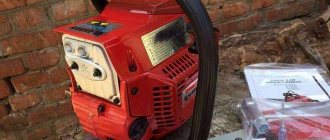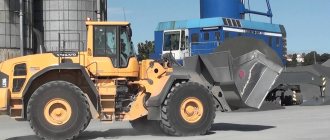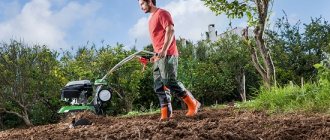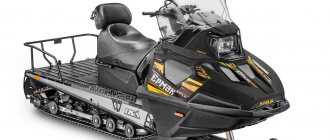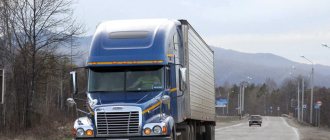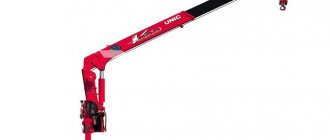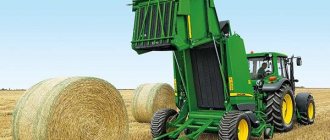Characteristics
Technical characteristics of the equipment:
| Length | 2 650 mm |
| Width | 2 850 mm |
| Height | 3 850 mm |
| Working tire size | 1 400 mm |
| Roll parameters | Length - 1,500 m Diameter - 1,600 m Weight - up to 450 kg |
| Roll counter | Eat |
| Performance | Up to 10 pieces |
| Minimum vehicle engine power | 80 horsepower |
| Maximum power take-off speed | 540 rpm |
| Knitting with twine | Eat |
| Mesh knitting | Eat |
| type of drive | Pneumatic |
| Socket | Eat |
| Selection mechanism | With teeth |
| Turning on the knitting machine | Automatic |
| Number of threads | 2 |
| Transport speed | 25 km/h |
| Number of cylindrical elements | 2 |
| Full mass | 1,800 kg |
Description of the Class baler: the technique makes it possible to collect straw and hay and press them into windrows without loss of product weight.
CLAAS balers
The CLAAS line of machines for pressing forage crops is designed in such a way that any farm, regardless of its size and profile, can choose the equipment that is optimally suited in terms of productivity and the size of the harvested bales and rolls.
The most powerful and highly productive in the CLAAS family of balers are the QUADRANT large-pack balers, which form rectangular bales ranging in size from 0.8 x 0.5 m to 1.2 x 0.9 m. In the QUADRANT 5200 , a high bale density is ensured by 56 piston strokes per minute and a pre-baling chamber with hydraulic control. At the same time, all settings that affect the density are adjusted automatically by pressing one button, thanks to which even an inexperienced operator can operate the machine at maximum productivity.
CLAAS round balers are represented by the ROLLANT and VARIANT models. The former have a pressing chamber of a fixed volume, while the latter have an adjustable volume. Moreover, today it is ROLLANT machines that are the best-selling balers in the world. One of the distinctive features of the ROLLANT 520/540 is the use of the latest HD profile rollers for an even crop flow under all harvesting conditions. For grinding dry materials, a ROTO CUT rotor with 7 or 14 knives can be used.
VARIANT balers makes this machine versatile and efficient for harvesting silage, hay or straw. The bale is dumped in just 6 seconds - the time between opening and closing the rear lid. And direct formation and excellent shape of rolls is ensured by 4 endless pressing belts. High productivity is facilitated by the fast rotation speed of the belts - 3 m/s and an accurate and reliable strapping system.
Models
The model range includes:
- Rollant 44;
- Rollant 46;
- Rollant 42.
Rollant-44
Technical parameters of the Claas Rollant-44 baler:
| Weight | 2,500 kg |
| dimensions | 3.5*3.85*2.25 m |
| Mechanism grip width | 1,4 |
| Roll parameters | Weight - up to 350 kg Length - 1,200 mm Diameter - 1,200 mm |
| Performance Level | Up to 25 pieces per hour |
| Highest PTO rotation speed | 540 rpm |
| Twine box | Eat |
| Automatic feeding of binding material | Eat |
| Finished roll counter | Eat |
| Minimum power of the vehicle with which the equipment is supplied | 50 horsepower |
| type of drive | Hydraulic |
| Country of Origin | Germany |
| Tool container | Eat |
| Number of hydraulic cylinders | 3 |
| Diameter of cylindrical elements | 6.7 cm |
| Bale chamber type | Roller |
| Roller profile | Ribbed |
| Working speed | 9 km/h |
Rollant-46
Parameters and indicators of the pick-up Class Roland-46:
| Gross equipment weight | 1900 kg |
| Working tire | 1400 mm |
| Roll parameters | Length - 1.2 m Diameter - 1.2 m Weight - 450 kg |
| Mesh knitting | Eat |
| Dimensions | Length - 3850 mm Width - 2400 mm Height - 2550 mm |
| Knitting with twine | Eat |
| Automatic knitting | Eat |
| Roll counter | Eat |
| Baling chamber | Roller type |
| Brake system type | Pneumatic |
| Maximum number of PTO rotations | 540 rpm |
| Minimum power of the power unit of a tractor or walk-behind tractor | 50 horsepower |
| Performance Level | Up to 15 pieces per hour |
| Transport speed | 27 km/h |
| Working speed | 10 km/h |
| Number of hydraulic cylindrical elements | 2 |
| Cylinder diameter | 60 mm |
| Minimum traction class of transport | 1,5 |
| Container for twine and tools | Eat |
Rollant-42
Technical parameters and characteristics of the Rollant-42 model:
| Length | 3850 mm |
| Width | 2350 mm |
| Height | 2550 mm |
| Working tire size | 1,540 mm |
| Roll parameters | Length - 1200 mm Diameter - 1000 mm Weight - up to 300 kg |
| Performance | 10 pieces per hour |
| Minimum vehicle engine power | 30 horsepower |
| Maximum power take-off speed | 540 rpm |
| Knitting with twine | Eat |
| Number of rollers | 12 |
| Mesh knitting | Eat |
| type of drive | Pneumatic |
| Socket | Eat |
| Turning on the knitting machine | Automatic |
| Number of threads | 2 |
| Transport speed | 27 km/h |
| Number of cylindrical elements | 2 |
| Full mass | 1,800 kg |
| Material from which the bale chamber is made | Metal |
| Type of mechanism responsible for feeding twine | Electrical engine |
Less popular
Less popular models include Markant Klaas 40 and 34.
Technical parameters of the Class-34 model:
| Type | Bale |
| Working tire size | 1.5 m |
| Knitting device drive type | Chain |
| Number of splines | 6 |
| Bale dimensions | Length - 1.3 m Width - 0.42 m Height - 0.36 m |
| Maximum finished bale weight | 35 kg |
| Material used for winding | Leg-split |
| PTO rotation speed | 540 rpm |
| Average productivity per work shift | 1500 bales |
| Unloading from the bale chamber | Mechanical |
| Bale counter | Eat |
| Mechanism lubrication system | Syringing |
Markant-40 modification parameters:
| Type | Bale |
| Working tire size | 1 400 mm |
| Drive unit | Chain |
| Number of splines | 6 |
| Bale parameters | 1.3*0.42*0.32 m |
| Power take-off speed | 540 rpm |
| Working speed | 7 km/h |
How to choose a baler?
The agricultural machinery market is filled with forage harvesting units from various manufacturers, with equally diverse technical potential and modifications.
How not to get confused, what to pay special attention to?
When choosing a special vehicle, you should not rely solely on the successful marketing of interested companies or proceed only from the purchase price.
A low price can hide an equally low quality of assembly, materials, and therefore productivity and wear resistance.
Main criteria
Based on the comparative characteristics and recommendations set out in the article, compare them with the following indicators:
1. Compliance with the conditions, potential, and objectives of your specific farm
Namely:
- For what livestock, in what volumes, what kind of feed needs to be prepared.
- What types of plant crops are planned for processing.
- What areas need to be harvested from?
- What are the deadlines for procurement work?
2. Specifications
Pay attention to:
- special vehicle power;
- quality of design, materials, wear resistance;
- productivity level;
- density of formed ligaments;
- model, dimensions of the pressing chamber;
- speed;
- working width;
- cost-effectiveness, ease of use and maintenance.
3. Manufacturer
It is preferable to choose a special vehicle from a well-known manufacturer with a proven track record of quality equipment.
In particular, John Deere is a leader in the production of reliable, wear-resistant agricultural equipment.
Regardless of the size of the agricultural enterprise, volume and type of work, this manufacturer will have the necessary equipment.
John Deere produces cars with cameras of constant and variable volume.
Claas has proven itself to be one of the most conscientious, reliable manufacturers and importers of feed harvesting units on the world market, in farms in Russia and the CIS.
The following are in great demand:
- roll special machines of the Claas ROLLANT, Claas VARIANT series,
- bale – MARKANT, QUADRANT.
Sipma is a popular company among Polish manufacturers, whose product range contains a sufficient selection of high-quality and relatively inexpensive agricultural machinery.
Do you want to know which baler is better: Claas, Sipma or John Deere?
Remember the main advice: the one that will be most profitable on YOUR farm.
Don’t forget that by purchasing a forage harvesting unit with basic equipment, you can modify it, make it more comfortable, and adapt it best to the requirements of the agricultural enterprise by purchasing additional equipment.
4. Price
Not every farmer can afford to buy an expensive special machine, and, in other cases, there is no need to overpay for the brand.
Economy option
Relatively inexpensive machines for small volumes of procurement work, forming +-25 packages/hour, with simple equipment, produced in Russia, Belarus, Poland, Italy.
Belarusian rolls are popular on the market today. They are somewhat inferior in compaction density to Western models, but are quite suitable as an economy class option.
In terms of bale units, there is a significant demand for Polish and Italian models, which are cheaper than analogues of world brands.
All of them can be equipped with devices for tying with mesh or film.
- A livestock farming enterprise that produces hay/straw may well opt for a low-cost bale or roll machine.
- However, when planning to use a pick-up for making silage, you should not save money. Buy a high-strength unit equipped with a shredder and the ability to wrap with mesh.
Moderately expensive
Middle-class Western-made machines will perfectly cope with the tasks of farming. They are a little more expensive, but the prices are quite reasonable.
If you have the funds, when purchasing a unit, proceed from the degree of its versatility. Choose one with a variable volume chamber and a chopper.
Attention!
Do you want to take advantage of the opportunity to have high-quality equipment at your disposal while saving money?
We can offer you used square balers from a European manufacturer, which have not been used in the CIS, have been thoroughly tested, and are fully prepared for use.
CLAAS recommendations for operating ROLLANT and VARIANT balers
In order to achieve maximum efficiency, a number of rules must be observed when operating CLAAS balers. The company's specialists, in particular, recommend:
- When picking up windrows, you should move at an optimal speed of about 8-10 km/h, which will allow you to achieve maximum bale density.
- A zigzag trajectory of movement - from one side of the roll to the other every 15-20 m will ensure a uniform flow of mass and, accordingly, the formation of dense rolls of the correct shape.
- When used for net tying, the machine's productivity increases.
- If the baler cover is open for more than 10 seconds, it is recommended to disable the PTO.
- Do not use the high pressure function when using the machine for the first time; frequent operation of the claw coupling of the cardan shaft occurs; hay, straw or haylage has high moisture content
By following these recommendations and observing the maintenance regulations when using CLAAS balers, your farm will be able to quickly and efficiently produce high-quality feed and recoup the investment in the equipment within several years.


